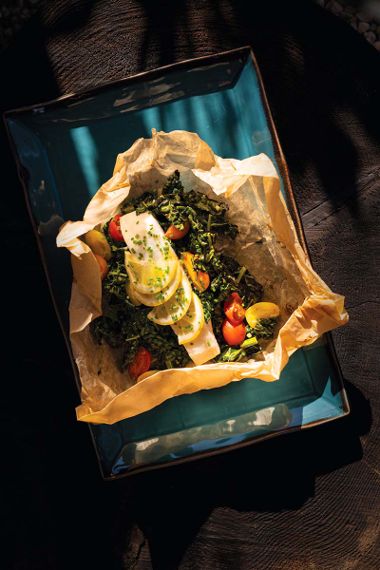
Steaming fish in parchment-paper packets, also known as cooking en papillote, is a classic technique that allows you to cook all your vegetables and fish at the same time in a quick, easy, and convenient way. Flavours of lemon, garlic, and spicy dried chili make this a simple, yet showstopping meal.
Sustainability status
Wild-caught Pacific halibut has Ocean Wise and Marine Stewardship Council certifications and is fished using longlines, which is a more selective method of fishing that results in less bycatch.
Prep party
Involve family or guests in the prep and have everyone make their own packet. Once you’ve mastered the technique, it’s easy to change up the ingredients. Make sure you select vegetables that will cook at the same rate as the fish.
Steamed Pacific Halibut Packets with Kale, Grape Tomatoes, and Garlic Lemon Chili Oil
Ingredients
- 2 Tbsp (30 mL) extra-virgin olive oil
- 1/2 tsp (2 mL) crushed red pepper flakes
- 4 garlic cloves, peeled and finely crushed
- 1 lemon
- 6 cups (1.5 L) finely chopped Cavolo Nero (Italian) kale
- 4 - 6 oz (170 g) pieces wild BC halibut, skinless
- 2 cups (500 mL) grape tomatoes, halved
- 2 tsp (10 mL) chopped chives, for garnish
Nutrition
Per serving:
- calories310
- protein44 g
- total fat12 g
- sat. fat2 g
- total carbohydrates6 g
- sugars3 g
- fibre2 g
- sodium116 mg
Directions
01
Preheat oven to 400 F (200 C).
02
For chili oil, in small bowl, combine olive oil, garlic, and chili flakes. Zest lemon and add to bowl, reserving remainder of lemon.
03
In large bowl, toss kale with approximately 3/4 of the chili oil mixture and allow to stand for about 15 minutes.
04
From half of reserved zested lemon, cut 4 thin slices, crosswise, and then cut slices once more so you have 8 half-moons. You should now have 8 half-moons and just over half a lemon. Set aside while you assemble fish packets.
05
Cut parchment paper into 4 pieces measuring approximately 20 x 14 in (51 x 37 cm). On large work surface, lay parchment pieces out flat and place 1/4 of kale in centre of each piece. Top with a portion of halibut, season with salt and pepper to taste, and arrange tomatoes around each piece of halibut. Divide and drizzle remaining chili oil and squeeze juice from remaining half of lemon over each piece of halibut. Finally, top each piece of halibut with 2 lemon half-moons. Seal packets by folding long edges of parchment toward centre, rolling and crimping up edges.
06
Place sealed packets on large baking sheet and bake in preheated oven for 12 minutes. To serve, either let everyone dive into their own packet or, for a more formal presentation, open packets and, with a large spatula, sweep contents of each packet onto individual plates. Garnish with chopped chives, and enjoy.




